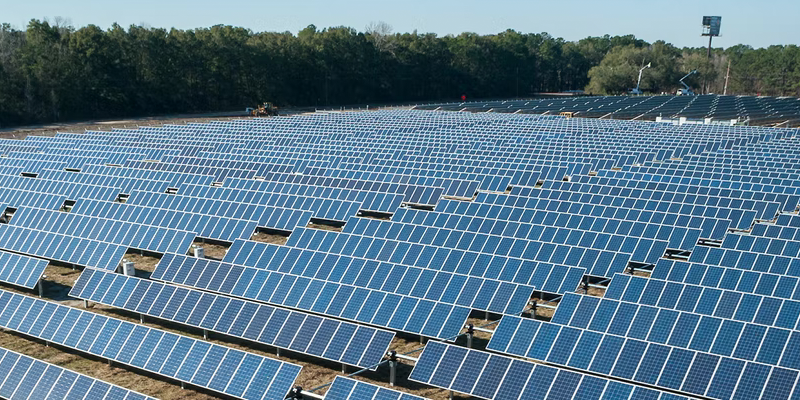What Are the Pros and Cons of Solar Farms?

Written by
Justin Kuepper
Published on
Mar 31, 2022
Last updated
Mar 31, 2022
Most people have driven past rows of solar panels near cities or airports. These solar farms provide utility-scale renewable power generation for nearby neighborhoods or power-hungry facilities. However, environmental advocates argue that some solar farms destroy wildlife habitats and inhibit plant life by blocking the amount of sunshine reaching the ground.
Let's take a closer look at solar farms, their pros and cons, and some potential solutions in the works.
What Are Solar Farms?
Solar farms are simply collections of solar arrays that harness sunlight to produce renewable energy. While rooftop solar can power a single home, utility-scale renewable energy is critical to reducing global carbon emissions. Solar farms are an excellent way to supply carbon-free power to the electrical grid without generating pollution.
The amount of energy that solar farms generate depends on their scale and the amount of sunlight the region receives year-round. For example, the Desert Sunlight Project in Riverside County, California, generates 550 megawatts (MW) of energy every day. That's enough to power 160,000 homes and offset the equivalent of 60,000 cars.
Solar Farm Pros
- Carbon Reduction: Solar farms generate power without any carbon emissions, eliminating the need for power generation from coal or other carbon-heavy sources. And, of course, burning less fossil fuel helps achieve critical climate goals and improves resilience.
- Low Maintenance: Solar farms require far less maintenance than wind turbines, hydroelectric dams, or other renewable energy sources since there are no moving parts. Aside from periodic cleaning, solar panels can last decades with minimal maintenance.
- Noiseless: Solar farms don't generate any noise pollution. Aside from wind turbine noise, fossil fuel drilling and refining generates a significant amount of noise pollution. Solar panels generate little more than a quiet hum of electricity.
- Renewable: Sunlight provides a constant and reliable source of electricity. While there may be cloudy days, solar farms tend to be built in locations with reliable sunlight, such as deserts. And battery storage provides flexibility when it comes to releasing energy.
- High-Margin: Solar farms have very low recurring costs after the initial investment, and their productivity doesn't decline much over time. As a result, solar farms make for an attractive investment for both governments and individual investors.
Solar Farm Cons
- Wildlife Impact: Solar farms require a lot of space that may be home to plant and animal species. As a result, installing solar farms can negatively impact these environments, although solar firms can mitigate the impact with proper planning and new strategies.
- Variable Production: Solar farms generate electricity from sunlight, meaning they don't generate anything at night or when the sky is cloudy. As a result, energy storage is becoming a key concern for the industry to smooth out production variability.
- Upfront Cost: Solar farms have a high upfront cost in terms of land leasing and acquisition, solar panel manufacturing, and battery system installation. Energy storage, in particular, is becoming a key cost center for solar farms, making them less viable.
- Solar Waste: Solar panels have a useful life of about two decades, but photovoltaic waste is becoming a concern. Regulators estimate that large amounts of solar waste could show up in the 2030s, making recycling strategies critical to the industry's future.
- Low Efficiency: Solar farms may have unlimited access to the sun for energy, but they're less efficient at converting that energy than other industries. In particular, they have a low capacity factor—or operating capacity to peak capacity ratio.
Investing in Solar Farms
Solar farms have become a popular investment due to their compelling economics. While profitability varies by project, solar farms generally provide a 10% to 20% return on investment. Many projects recoup their upfront costs in five to ten years and then enjoy 25 to 30 years of high-margin electricity production.
In addition, many solar farms operate under long-term contracts with private or public utilities, providing a predictable revenue stream and operating margin over time. And, since solar is cheaper than many fossil fuels, some solar farms directly recruit consumers, offering them a discount on their energy bills to switch over.
Unfortunately, many solar projects are run by private companies that only offer access to deals to accredited or institutional investors through private placements. However, a growing number of crowdfunding platforms offer non-accredited retail investors access to investments in purpose-built solar projects.
The three most popular platforms are:
- Energea enables anyone to invest in solar farms located in the U.S., Brazil, and South Africa. In addition, the company offers a monthly dividend with a 10%+ internal rate of return.
- Renewables offers debt securities that fund solar farms and pays a 6% interest rate with the first $100 guaranteed, thanks to a generous backer.
- Raise Green makes it easy to invest in various clean energy projects through equity and debt securities.
Investors may also want to consider green bonds or other traditional publicly-traded securities that fund these kinds of projects. While they don't provide direct exposure to solar farms, they offer diversification that may be better suited for retirement portfolios.
The Bottom Line
Solar farms have become a popular utility-scale solution powering the move toward renewable energy. While there are many pros and cons to keep in mind, most consumers can appreciate the need to transition to renewables. Many investors also appreciate the compelling economics that solar farms offer—including individual investors.
If you're looking for ways to maximize the impact of your portfolio, VirtueScout makes it easy to find the right opportunities. And sign up for our free newsletter to get real-time insights into the latest high-impact crowdfunding opportunities and traditional investments.
